Here's the text.
What is AED?
Last Updated August 5, 2024
What is AED?
Sudden heart death is often caused by severe arrhythmia called ventricular fibrillation. Ventricular fibrillation is a condition in which the heart muscle trembles irregularly and falls into a state in which it cannot serve as a pump that pumps blood throughout the body. Such symptoms can lead to rapid death. . The only treatment is defibrillation with an electric shock. Defibrillation refers to removing ventricular fibrillation, and if the time from ventricular fibrillation to defibrillation is delayed by one minute, the possibility of rehabilitation is reduced by 7 to 10%.
Therefore, an automatic external defibrillator (AutomatedExternalDefibrillator), commonly known as AED, was developed to perform defibrillation as soon as possible.
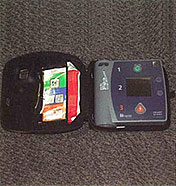
Raildar Medical Japan Co., Ltd.
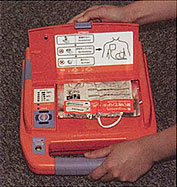
NIHON KOHDEN CORPORATION
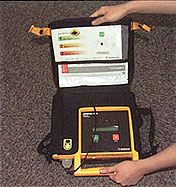
Fijio Control Japan Co., Ltd.
AED is a medical device that uses a computer, automatically analyzes the patient's electrocardiogram and determines the waveform of the ECG with high accuracy when an electric shock is required. Voice instructions are given to rescuers only when an electric shock is required, and safety is ensured so that no electric shock is performed in other cases. With the advent of AEDs, it is now possible for non-medical professionals such as doctors to perform defibrillation safely.
Mandatory maintenance of emergency equipment such as AED
Facilities where many people gather are required to have emergency equipment such as AEDs. (From April 1, 2009) In Yokohama City, we will endeavor to maintain emergency equipment such as AEDs in buildings of a certain size or larger, sports facilities, and station buildings. This is to ensure that first aid can be provided promptly in the event of a victim at these facilities.
Notice of mandatory AED installation (PDF (PDF: 138KB))
Search for AED installation location
https://www.qqzaidanmap.jp/ (external site)
The Japan Emergency Medical Foundation website
Structure and Function of AED
The AED consists of the main body and electrode pads. The size is about A4 size and weighs 1.5 to 3 kg, making it easy to carry. As a result of the AED analyzing the electrocardiogram, when ventricular fibrillation or ventricular tachycardia is detected, the lamp of the main unit flashes, and a voice instruction is issued to the rescuer to perform an electric shock. The rescuer will follow the AED voice advice and press the electric shock button or perform cardiopulmonary resuscitation as needed. The following table briefly shows the structure and procedure of use with actual AED photos.
AED operation procedure

FR2 (Rail Dal Medical Japan Co., Ltd.)

AED-9100 (Nippon Electric Industry Co., Ltd.)

LIFEPAK500 (Fijio Control Japan Co., Ltd.)
1.Prepare an AED

Preparation for FR2

AED-9100 preparation

Preparation for LIFEPAK500
2.Turn on the power
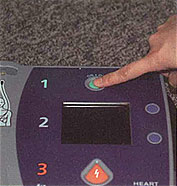
Turn on the power
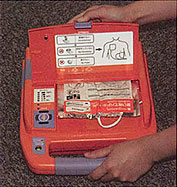
Turn on the AED-9100 power
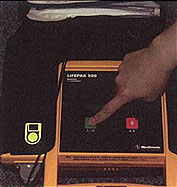
Turn on the LIFEPAK500 power supply
3.Open the pad
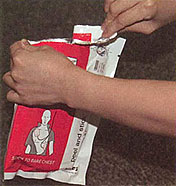
Open the pad
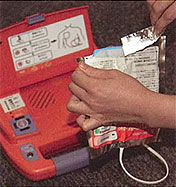
Open the AED-9100 pad
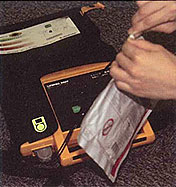
Open the LIFEPAK500 pad
4.Put a pad

Apply the FR2 pad
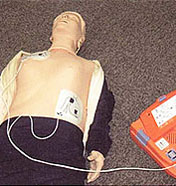
Paste the AED-9100 pad
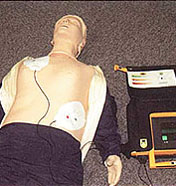
Paste the LIFEPAK500 pad
5.Connect the connector
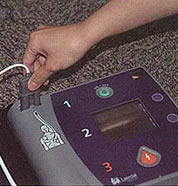
Connect the FR2 connector
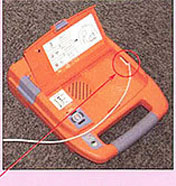
Connect the AED-9100 connector
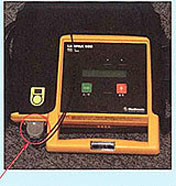
Connect the LIFEPAK500 connector
6.If there is a defibrillation message, press the energized button.
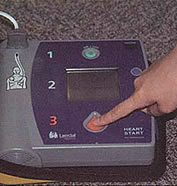
Press the FR2 energized button
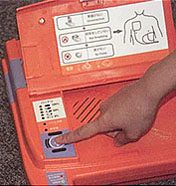
Press the AED-9100 energized button
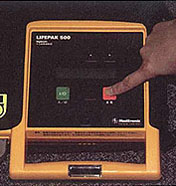
Press the LIFEPAK500 energized button
Recording of automatic external defibrillators (AEDs) approved by pharmaceutical affairs as of October 2004
Notes (About use for preschoolers)
AEDs can be used regardless of the age of the victim.
If there is a pad for preschoolers, it can be used only for the victims of preschoolers (children before going to elementary school).
The position where the pad is applied should be as per the illustration drawn on the pad.
Other procedures are similar to how to use AEDs for adults. If there is a mode for preschoolers, it can be used only for those who are similar to the pad for preschoolers.
In this case, pads for elementary school students to adults are used, but since they are larger than pads for preschoolers, care should be taken so that pads do not touch each other.
If there is no switch between the pad for preschoolers or the mode for preschoolers, use the pad for elementary school students to adults.
For victims of elementary school or junior high school students and above, use pads for elementary school students to adults. Preschool pads cannot be used for elementary school or junior high school students or older due to lack of electricity flowing.
Source: "Revised 6th Edition Guidelines for Emergency Resuscitation 2020 (for citizens, commentary)"
You may need a separate PDF reader to open a PDF file.
If you do not have it, you can download it free of charge from Adobe.
![]() To download Adobe Acrobat Reader DC
To download Adobe Acrobat Reader DC
Inquiries to this page
Emergency Guidance Division, Fire Bureau Emergency Department
Telephone: 045-334-6797
Telephone: 045-334-6797
Fax: 045-334-6710
Email address: sy-kyukyushido@city.yokohama.lg.jp
Page ID: 912-206-305







